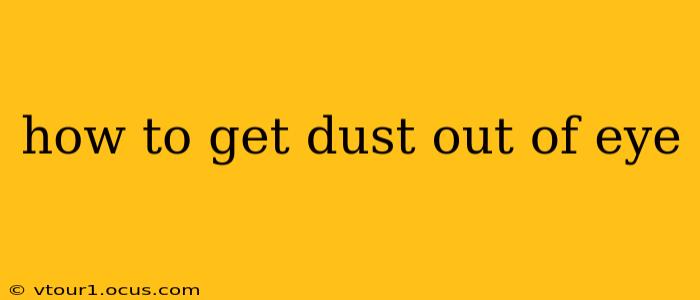Getting dust in your eye is a common and irritating experience. The feeling of a foreign object scratching your cornea can be incredibly uncomfortable, prompting immediate action. This guide provides comprehensive steps on how to remove dust from your eye safely and effectively, along with information on when to seek professional medical help.
What to Do Immediately When You Get Dust in Your Eye
The first instinct might be to rub your eye, but resist this urge! Rubbing will only irritate your eye further and potentially scratch your cornea, leading to more serious problems. Instead, follow these steps:
-
Blink Repeatedly: Your natural tear production is your first defense. Blinking helps wash the dust away. Try blinking rapidly for a minute or so.
-
Rinse With Clean Water: If blinking doesn't work, gently flush your eye with clean, lukewarm water. Tilt your head and let the water flow over your eye from the inner corner (near your nose) to the outer corner. Avoid using soap or any other solutions, as these can irritate your eye further. A clean cup or bottle can be used for this purpose.
-
Avoid Touching Your Eye: Keep your hands clean and avoid touching your eye as much as possible to prevent infection.
How to Remove Larger Particles from Your Eye
If blinking and rinsing haven't removed the dust and you can see the particle, you might be able to remove it:
-
Wash Your Hands: Thoroughly wash your hands with soap and water.
-
Use a Clean Cotton Swab: Gently try to wipe the particle away with a clean, damp cotton swab. Only attempt this if you can easily see the particle and it isn't embedded in your eye. Do not apply pressure.
-
Avoid Using Tweezers or Sharp Objects: Never use tweezers, needles, or other sharp objects to remove a particle from your eye. This can cause serious damage to your cornea.
When Should You See a Doctor?
While most dust particles can be removed at home, there are instances when you should seek medical attention immediately:
What if the dust is still in my eye after trying home remedies?
If the dust remains in your eye after trying these home remedies, or if you experience persistent discomfort, blurred vision, or significant eye redness, it's crucial to seek medical attention. A doctor can properly assess the situation and remove the particle safely.
What if I have a severe reaction or blurry vision?
Blurry vision, severe pain, or a persistent feeling of something being in your eye warrants immediate medical attention. These symptoms could indicate a more serious issue requiring professional care.
What if the particle seems embedded in my eye?
Never attempt to remove an embedded particle yourself. This requires the expertise of an ophthalmologist or optometrist.
What are the potential risks of not removing the dust?
Leaving a foreign body in your eye, even a small dust particle, increases the risk of infection, corneal abrasion (scratching of the cornea), and potential vision impairment.
What are the long-term effects of ignoring an eye injury?
Ignoring eye injuries can lead to chronic eye irritation, scarring, and even vision loss. Prompt treatment is essential for minimizing long-term complications.
Prevention is Key: Protecting Your Eyes from Dust
Protecting your eyes from dust is crucial. Here are some preventive measures:
- Wear Protective Eyewear: When working in dusty environments, always wear safety glasses or goggles.
- Use a Mask: A dust mask can help prevent dust particles from entering your eyes.
- Clean Your Surroundings: Regularly clean your home and workspaces to minimize dust accumulation.
By following these guidelines, you can effectively deal with dust in your eye and protect your vision. Remember, it's always better to err on the side of caution and seek professional help when needed.
